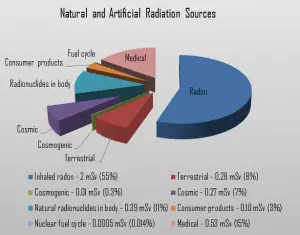Cosmic radiation refers to sources of radiation in the form of cosmic rays that come from the Sun or outer space. The earth has always been bombarded by high-energy particles originating in outer space that generate secondary particle showers in the lower atmosphere. Charged particles (especially high-energy protons) from the Sun and outer space interact with the earth’s atmosphere and magnetic field to produce a shower of radiation (i.e., air shower), typically beta and gamma radiation.
The primary cosmic radiation consists of a mixture of high-energy protons (~87%), alpha particles (~11%), high-energy electrons (~1%), and a trace of heavier nuclei (~1%). The energy of these particles ranges between 108 eV and 1020 eV. A very small fraction are stable particles of antimatter, such as positrons or antiprotons. The precise nature of this remaining fraction is an area of active research.
 Subsequently, a large number of secondary particles, in particular, neutrons and charged pions, are produced due to interactions between primary particles and the earth’s atmosphere. Since pions are short-lived subatomic particles, the subsequent decay of the pions results in the production of high-energy muons. At ground level, the muons, with energies mostly between 1 and 20 GeV, contribute about 75 % of the absorbed dose rate in free air. The dose rate from cosmic radiation varies in different parts of the world and depends strongly on the geomagnetic field, altitude, and solar cycle. The cosmic radiation dose rate on airplanes is so high that, according to the United Nations UNSCEAR 2000 Report, airline flight crew workers receive more dose on average than any other worker, including those in nuclear power plants.
Subsequently, a large number of secondary particles, in particular, neutrons and charged pions, are produced due to interactions between primary particles and the earth’s atmosphere. Since pions are short-lived subatomic particles, the subsequent decay of the pions results in the production of high-energy muons. At ground level, the muons, with energies mostly between 1 and 20 GeV, contribute about 75 % of the absorbed dose rate in free air. The dose rate from cosmic radiation varies in different parts of the world and depends strongly on the geomagnetic field, altitude, and solar cycle. The cosmic radiation dose rate on airplanes is so high that, according to the United Nations UNSCEAR 2000 Report, airline flight crew workers receive more dose on average than any other worker, including those in nuclear power plants.
Natural Neutron Background
We also have to include the neutrons at ground level. Cosmic rays interact with nuclei in the atmosphere and also produce high-energy neutrons. According to UNSCEAR, the fluency of neutrons is 0.0123 cm-2s–1 at sea level for a geomagnetic latitude of 45 N. Based on this, the effective annual dose from neutrons at sea level and 50-degree latitude is estimated to be 0.08 mSv (8 mrem). The neutron flux measures higher in the vicinity of larger, heavier objects, e.g., buildings or ships. This effect is known as “cosmic ray induced neutron signature” or “ship effect,” as it was first detected with ships at sea. Cosmic rays create showers in the atmosphere that include a broad spectrum of secondary neutrons, muons, and protons. The secondary neutrons may be of very high energy and induce spallation events in materials at ground level. Therefore in the vicinity of larger, heavier objects, these multiple neutrons produced in spallation events are referred to as “ship effect” neutrons.
Neutrons produced in the upper atmosphere are also responsible for the generation of radioactive carbon-14, which is the best-known cosmogenic radionuclide. Carbon-14 is continuously formed in the upper atmosphere by interacting cosmic rays with atmospheric nitrogen. On average, one of every 1.3 x 1012 carbon atoms in the atmosphere is a radioactive carbon-14 atom. As a result, all living biological substances contain the same amount of C-14 per gram of carbon, 0.3 Bq of carbon-14 activity per gram of carbon. As long as the biological system is alive, the level is constant due to the constant intake of all isotopes of carbon. When the biological system dies, it stops exchanging carbon with its environment, and from that point onwards, the amount of carbon-14 it contains begins to decrease as the carbon-14 undergoes radioactive decay.
Dose Rate in Airplane
The radiation field at aircraft altitudes consists of neutrons, protons, and pions. In-flight, neutrons contribute 40 – 80% of the equivalent dose, depending on the geomagnetic field, altitude, and solar cycle.